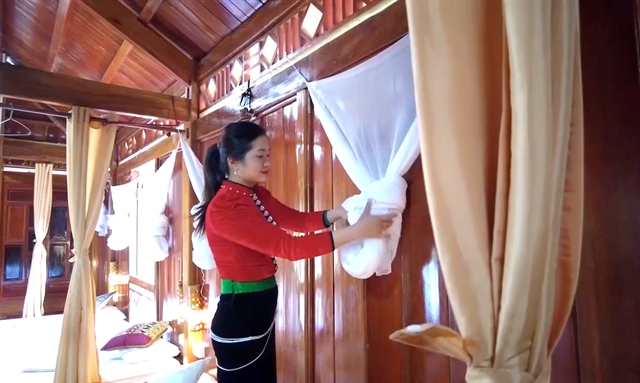 Society
Society

 |
| A homestay in Đăk Tăng Commune, Kon Plông District, Kon Tum Province. — VNA/VNS Photos |
HÀ NỘI — A series of homestays and farmstays have sprung up in many provinces and cities in recent years due to the increasing demand from domestic and foreign tourists.
However, there have also been numerous violations related to the construction and operation of this tourism model, causing headaches for local authorities.
Tiền Phong (Vanguard) newspaper reported that there are about 37 homestays and farmstays in Đắk Nông Province. However, based on the report from the provincial People's Committee, only Lá homestay in Đắk Lao Commune, Đắk Mil District, has been assessed to meet all the necessary conditions for serving tourists.
In Đắk Nông, tourists are always impressed by the beautiful landscape of Tà Đùng Lake in Đắk Som Commune, Đắk G’long District, which has been likened to Hạ Long Bay in the mountains.
However, this area is being invaded by homestays and farmstays, destroying the natural landscape.
Trần Nam Thuần, chairman of the People's Committee of Đắk G’long District, admitted that these establishments have been built on agricultural land since 2016. Until now, there has been no proper planning for these developments, leading to significant difficulties in management.
The results of last year's inspection revealed a total of 56 violations, including unauthorised construction on agricultural land, construction exceeding the permitted residential area, and other violations related to land management and construction in Đắk Som Commune from 2015 to 2021.
Tôn Thị Ngọc Hạnh, vice chairman of the provincial People's Committee, said that the rapid development of homestays is creating many difficulties for the management and handling of violations by local authorities.
"Đắk Nông Province authorities said there should be no tolerance or turning a blind eye to misbehaviour within the province."
In Kon Tum Province, Kon Tum Rubber One Member Limited Company was granted a permit to build an eco-tourism guesthouse area in Măng Đen town, Kon Plông District in 2006.
However, the company did not carry out the project as permitted and instead leased the land to another company.
This action violated the regulations of the land law.
Currently, many homestays have been built illegally on this land, the newspaper reported.
In the northwest region, besides well-planned community-based homestays that comply with regulations and legal requirements, there are also many places where various homestays are put into operation without completing their legal procedures.
 |
| A member of staff at a homestay in Mường Sang Commune, Mường Sang District, Sơn La Province. |
According to statistics from the Department of Culture, Sports, and Tourism of Yên Bái province, there are currently more than 200 homestays, mainly in areas with strong tourism potential such as Nghĩa Lộ township, Trạm Tấu, Mù Cang Chải and Yên Bình districts.
Trịnh Thế Bình, the head of the Culture Division in Mù Cang Chải District, said there are 104 homestays in the district. More than 40 per cent of them have met the necessary conditions for operating accommodations. However, over 50 per cent of the remaining homestays have not yet completed the necessary procedures for land-use conversion, and fire prevention, but are still in operation.
According to Bình, these establishments are allowed to operate despite failing to meet all the conditions. This decision is made to accommodate the high demand during the tourist season.
The local authorities will continuously monitor, raise awareness, and provide guidance to homestay owners to promptly complete all the necessary legal procedures.
In the mountain district of Trạm Tấu, the statistics showed that there are currently 26 homestays operating, even though their legal documents are not yet fully completed.
Dương Phương Thảo, the Head of the Culture Division in Trạm Tấu District, community-based tourism has developed in recent years.
Some construction projects have not been converted according to the proper land-use purposes. However, the district still permits their operation to attract tourists.
As a famous tourist destination in the northwest region, Sa Pa in Lào Cai Province, has also witnessed a significant boom in homestay business.
There were 94 homestays in Sa Pa Township by 2010. The number soared to 108 by 2015 and reached 306 by 2019, and by 2022, it further increased to 364 establishments.
Due to construction violations and non-compliance with land laws, especially the uncontrolled proliferation of homestays, recently, the People's Committee of Sa Pa Township issued a plan to implement measures to re-establish discipline and order in land management, construction, and tourism service businesses in the locality.
Under this plan, the violating constructions will be required to be demolished.
On July 19, during the 15th Provincial People's Council's seventh sitting of Sơn La Province, Phùng Kim Sơn, director of the Department of Natural Resources and Environment, said that in Tà Xùa Commune, Bắc Yên District, and Mộc Châu District, there is an issue where some households and individuals are arbitrarily changing the land-use purposes and constructing buildings on agricultural land without proper authorisation.
Many project owners are not fully complying with the obligations of land users as stipulated in the 2013 Land Law. They are not using the land for the intended purpose, failing to declare and register land-use rights, not fulfilling the financial obligations, and not completing the necessary land-use change procedures.
The department is actively coordinating with relevant agencies to conduct inspections of land management, Sơn said.
It also advises the chairman of the provincial People's Committee to propose that the chairmen of the People's Committees of the districts sign commitments to enhance their roles and responsibilities in resource management and environmental protection, including effective land management. — VNS




